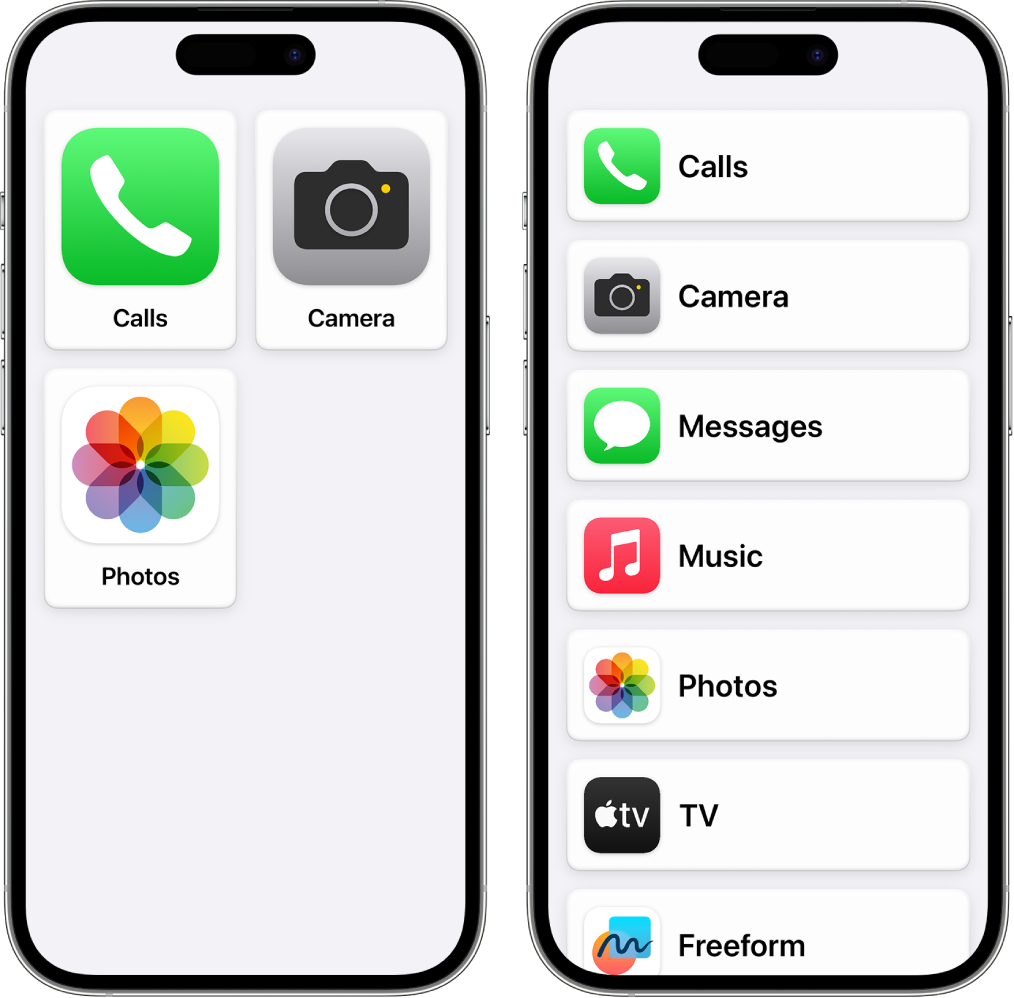When someone switches to a dumbphone, there is a common refrain: why not just dumb down your smartphone? Until recently, my answer would have been: it doesn’t work. It’s not enough. I’ve tried it all, and whatever “it” is, it’s too easy to bypass.
But a lot has changed since I last tried to tame my iPhone. This time, I enabled Assistive Access mode.
Assistive Access, “a distinctive iOS experience, with more focused features and a simplified user interface, which allows people with cognitive disabilities to use iPhone with greater ease and independence,” was released with minimal fanfare as part of iOS 17 in September 2023.1

An iPhone in Assistive Access mode looks a lot like a dumbphone. The sort of dumbphone people often ask for: one that can run WhatsApp, Spotify, Strava, Google Authenticator, and every app their specific workplace requires. So, not a dumbphone at all. A fettered smartphone.
And maybe that’s exactly what we need. The smartphone is useful. We use it for useful things: ordering groceries, taking notes, tracking runs. But many of us also use it for other things, for longer than we’d like. We use it as a pacifier, but we also use it as a tool. If it was possible to cleave the latter from the former, many of us would. Is it possible? Maybe.
I’ve written before about my failure to settings-adjust my way out of excessive smartphone use. If it is easy to set Screen Time limits on an iPhone, it is just as easy to reset them. For some people, deleting some apps and switching to grayscale will be enough. For other people, it won’t.
But Assistive Access mode is more than a toothless settings switch. It meaningfully changes the experience of using an iPhone. If you are an iPhone user who wants to spend less time, well, using your iPhone, it seems worth a try. So, I tried it.
Opting in, not out
App Store, Books, Calculator, Calendar, Camera, Clock, Compass, Contacts, FaceTime, Files, Find My, Fitness, Freeform, Health, Home, iTunes Store, Journal, Magnifier, Mail, Maps, Measure, Messages, Music, News, Notes, Passwords, Phone, Photos, Podcasts, Reminders, Safari, Settings, Shortcuts, Stocks, Tips, Translate, TV, Voice Memos, Wallet, Watch. 40 apps come installed on an iPhone by default. You can opt out of most of them, just like you can opt out of any interaction with any device. You can, to quote Tyler the Creator, “Just Walk Away From The Screen” or “Close Your Eyes.” But it’s hard.
It’s much easier to start with nothing and add what you need. That’s exactly what setting up Assistive Access requires you to do. You choose the apps to add to your phone; they are not chosen for you. You also choose who can contact you and who you can contact; whether each app is permitted to access your personal data.
I chose Calls, Camera, Clock, Google Authenticator, Google Maps, Wallet, and WhatsApp. I chose one person to contact: my husband. I chose not to allow any app to access my contacts, location, or photos unless it was strictly necessary to function. It felt good to choose.
More friction
One reason smartphones are so easy to spend so much time on? They’re seamless. Swipe, tap: you’re on another app. Every spare second of wait time, eliminated. Every micro-action, optimized. If you can’t figure out how to do something with the pinch of your fingers or press of a button, that’ll be fixed in the next iOS update.
Once you enter Assistive Access mode, you have left that hyper-optimized world. Features are intentionally hidden from you. I waited for seconds — seconds! — for WhatsApp to launch.
And if you want to go back? You must triple tap the home button. Tap “Exit Assistive Access.” Type in your password.
It doesn’t sound like much. But it’s certainly not seamless. It was enough friction to stop me — for about a week.
Am I going to set aside my Nokia 2780 and embrace my neutered iPhone? No. It turns out a triple click is not enough of a barrier between me and a mobile browser. After several days of mostly forgetting it existed, I remembered. And for the first time in two months, I scrolled. It was a nasty feeling. I turned it off and tucked it in my bag. I missed the way my flip phone snapped shut, anyway.
But that’s me. You’re you. Maybe you don’t want to spend $60 (or $600) on a dumbphone right now, which, fair. Maybe you get a lot of use — and joy — out of your iPhone. Maybe you want to edit, not eliminate it. Maybe you have the self-control to avoid that triple tap. Maybe you should switch on Assistive Access mode.
If you do, let me know how it goes.
I’m discussing Assistive Access mode here as a way to simplify your iPhone and reduce its addictive potential. It was designed as an accessibility tool. Digital minimalism aside, that is its most important function.


For me, disabling safari was the only way I was going to have a chance at some separation from my phone. After deleting all my social media accounts, I spent the equivalent amount of time browsing online.
This still seems like a good way: https://mehretbiruk.com/2021/05/10/smartphone-to-dumb-phone/
At the end of the day I never had the courage to have someone else block safari & app store with a passcode for me, so after much struggle I jumped over to a flip phone.
I wish you didn’t tell us how to get out of that mode 😂 although it would’ve only been one desperate google search away anyway